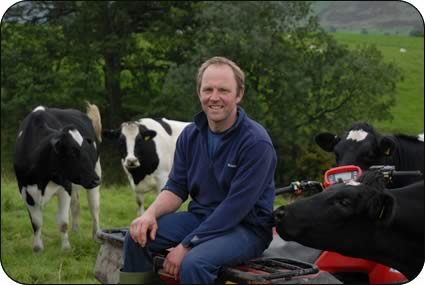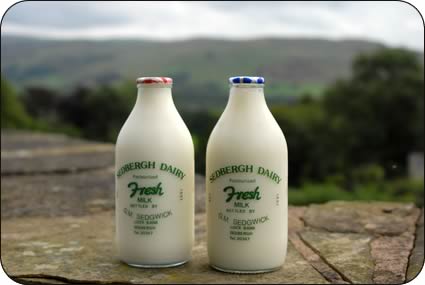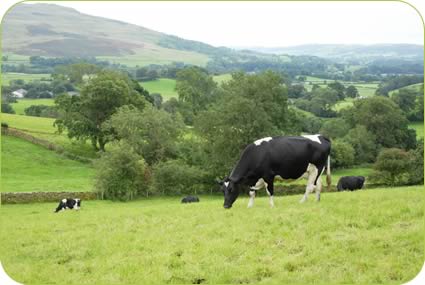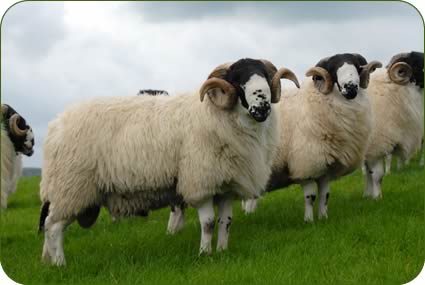Jennifer MacKenzie is an agricultural photo journalist with almost 30 year's experience. Operating from her base in Cumbria, Jennifer undertakes mainly industry-related freelance writing and photography.
Sedbergh Milk
A Cumbrian farming family has been adding value to its milk long before
recent drives to improve farm gate prices.
In fact, the Sedgwicks first began a milk round in 1897 at Lockbank Farm
on the outskirts of Sedbergh and now well over a century later Roger Sedgwick
and his wife Suzan along with Roger’s parents Geoff and Brenda supply
businesses and homes in the area with 500 pints of milk a day at peak times.
 |
| Roger Sedgwick and dairy cows |
The Sedgwicks can trace their roots back to 1140 in the Howgill area north
of Sedbergh and it was in 1894 that Roger’s great grandfather started
farming at Lockbank and subsequently started the milk round.
Then the milk was delivered twice a day in churns which proved difficult
at hay times in particular and there were 11 different farms delivering
milk – now there is only one.
Likewise the number of dairy farms in the area has decreased dramatically.
The Sedgwicks’s veterinary practice at one time had 92 dairy farming
clients – now there are 17.
The majority of the milk is sold to retail outlets which has included Sedbergh
School since 1927.
The Sedgwicks run a traditional farm, milking 40 principally Friesian type
cows and running a total of 85 head of cattle and 300 Rough Fell and some
Swaledale sheep on 56.9 acres of in-bye land and with common grazing rights
on Winder fell, part of the Howgill range, and 15ha on Frost Row.
 |
| the milk for sale |
Maintaining the milk round has helped keep the farm viable. “The
herd averages 6,000 litres a cow and milk price averages for 2008 are over
36p per litre from direct sales and from Dairy Farmers of Britain which
buys the rest,” said Roger.
“In September the average milk price will rise considerably because
of demand through the milk round.
“Unfortunately, DFB collects our milk every other day and if it falls
below 91,500 litres we are penalised by 4p per litre currently, we stand
to lose around £6,000 a year because of this system. We would like
to build on direct sales and I have considered other options, being less
labour intensive,” added Roger.
 |
| Cows grazing |
Increased competition led the Sedgwicks to pasteurise their milk on farm
in 1991 – a job which usually Suzan helps Roger with although she
currently has her work set with the couple’s baby Lewis, who was
born in August as well as their four year old son, John.
“The milk round has brought in money to what I wouldn’t call
an ideal dairy farm and while direct sales have decreased over the years,
now they have bottomed out and, in fact, we have some new retail customers,” said
Roger. “I think there is more interest in buying local products.”
Full milk, semi-skimmed and skimmed milk are sold as well as cream. The
milk is simply pasteurised – not homogenised – and customers
comment on the quality.
The herd calves all the year round. It is 91 per cent Friesian as Roger
believes the farm doesn’t grow enough grass to maintain Holstein
types and the Sedgwicks breed their own replacements using Genus sires.
 |
| Rough Fell shearling rams |
Cows with a history of foot trouble or which have lost a quarter are crossed
with the beef bull.
The herd is fed big bale silage and concentrate in the parlour. Sugar beet
straight out of the ground was being fed until the price escalated.
The cows this year were housed at night from early September because of
inclement weather conditions. Usually this is from the end of September.
Friesian bullocks and cross-breds were finished on the farm but now they
are sold store at 16 to 20 months old through Lancaster and Kendal markets.
They are fed silage, concentrates and sugar beet.
The Sedgwicks have also stuck with the area’s traditional sheep breed,
the Rough Fell. Their flock of 300 ewes comprises mostly registered Rough
Fells with a few Swaledales.
About 60 of the Rough Fells are crossed with the Texel which are finished
as early as possible, from June onwards, after lambing in mid March.
This year lambs weighing an average 36kg made up to £54 a head at
Kendal Mart.
The ewes which are bred pure lamb from March 24 with lambing well under
way by the second week in April.
Pure bred wether lambs are sold from November onwards, generally through
Hawes mart.
This year there was a record number of triplets – 17 sets, 16 of
which were pure-bred – and a set of Texel cross quads which Roger
attributes possibly to the ewes coming down to the fell gate up to three
weeks earlier than usual last autumn.
Roger has been actively involved with the Rough Fell Sheep Breeders’ Association,
selecting sheep for trade stands at sheep events as well as judging at
shows. He also featured in a video/DVD made by the society promoting the
breed.
Rough Fells from Lockbank were shown until 2006 when once again the family
won the hill breed championship at the Westmorland Show, an award they
had collected several times over the years, and Roger felt it was a good
time to quit.
The Sedgwicks also diversify into holiday accommodation in this popular
area of the Yorkshire Dales National Park. Their four-bedroomed house adjoining
the farm, The Mount, sleeps eight is open all year round and welcomes visitors
to the farm.

